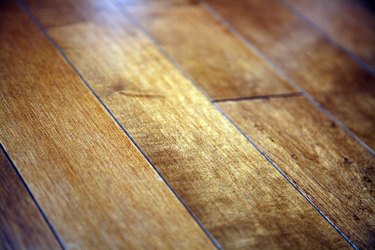
Despite the wide selection of linoleum, laminates, carpets and composite flooring materials, there's just something alluring about the timelessness of hardwood floors. They've been the standard in natural flooring for three centuries, and they're not going out of style any time soon. Manufacturers of today's hardwood flooring mill the planks with tongue-and-groove technology for a smooth fit. You may choose from a variety of flooring nailers, but there is only one correct way to install the planks.
Hardwood Flooring Planks
Video of the Day
Tongue-and-groove hardwood planks are all the same width, but may not be the same length. On one long side of a plank, you will find a groove that runs from end to end. On the other side, you'll see a smooth half-round lip that extends and runs from end to end. When you position the lip (tongue) of one plank into the groove of another, they will fit together like puzzle pieces. The ends of each plank also feature a tongue and groove.
Video of the Day
Tip
Sponsored tip: Need tools for your project? Check out RentalHQ and get connected with local businesses that’ll help you rent the equipment and tools you need.
Getting Started
The correct way to install hardwood flooring planks begins by positioning the first plank in one corner of your room along the longest wall and perpendicular to the floor joists. The groove of the plank should face the wall and the tongue should face outward. This makes the tongue accessible for nailing, but not the groove.
Flooring Nailers
Before flooring nailers, the installer used a hammer to drive a finish nail through the plank on the top of the tongue, right where the tongue meets the upper lip. He then used a nail set to countersink the nail to ensure that the nail head did not interfere with the fit of the next plank. Flooring nailers replaced the hammer and nail set method, but they shoot nails into the same spot – the top of the tongue.
Problems with Nailing the Groove
The wood on the tongue is much thicker than the wood on the inside of the groove and less likely to split when you drive a nail. A flooring nailer has a shoulder that fits over the tongue for accurate nail insertion, but a nailer doesn't fit on the groove edge. To nail the groove, you must nail by hand, but you have a very small space in which to work. In addition, you must countersink every nail to avoid interfering with the tongue of the next plank. For most applications, this isn't feasible or desirable.